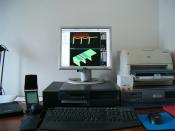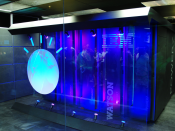1. Find an estimate of the risk-free rate of interest, krf. To obtain this value, go to Bloomberg.com: Market Data [http://www.bloomberg.com/markets/index.html] and use the "U.S. 10-year Treasury" bond rate as the risk-free rate. In addition, you also need a value for the market risk premium. Use an assumed market risk premium of 7.5%.
The Risk Free Rate of Interest known as KRF is 4.250% or 0.0425. This value was
obtained from www.bloomberg.com/markets/index.html. The Assumed Market Risk
Premium (Km) was previously given is the first question. Its assumed value was
listed as 7.5%.
2. Download this IBM Stock Information document (.pdf file). https://mycampus.aiu-online.com/courses/FIN410/Assignment_Assets/FIN410_u3ips.pdf
1. IBM's beta (ÃÂ) 1.64 for 5 years
2. IBM's current annual dividend $.80
3. IBM's 3-year dividend growth rate (g) 8.2%
4. Industry P/E 23.2
5. IBM's EPS. $4.87
3. With the information you now have, use the CAPM to calculate IBM's required rate of return or ks.
krf= .0425 km= .075 beta= 1.64
ks= krf + (km-krf) x beta
ks= .0425 + (0.075-.0425) x 1.64
ks=0.0958 or 9.58%
4. Use the CGM to find the current stock price for IBM. We will call this the theoretical price or Po. ks= 0.0958 D1= $0.812 g= 8.2% or .082
Po= D1/ks-g Po= $0.812/.0958-.082 Po= $58.84057971 ($58.84)
5. Now use appropriate Web resources to find IBM's current stock quote, or P. Compare Po and P. Do you see any differences? Can you explain what factors may be at work for such a difference in the two prices?
The answer to this portion of the question requires a detailed
understanding of what factors influence which areas of the market. To understand
this specific question we must first break apart the necessary information. The
essential key would be what the beta has been for...


